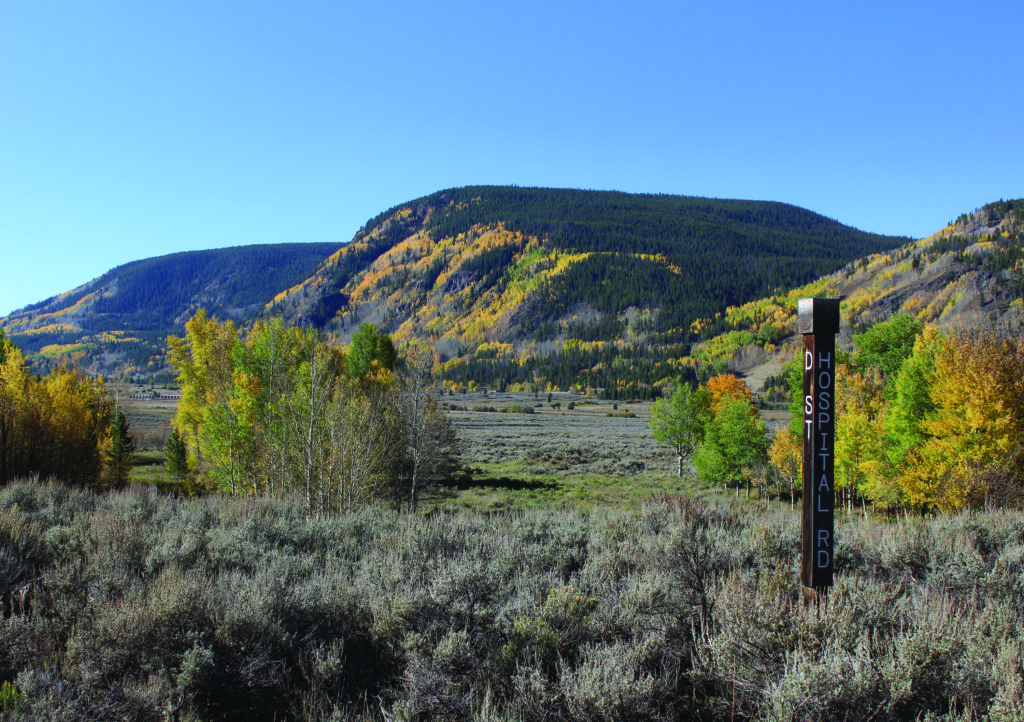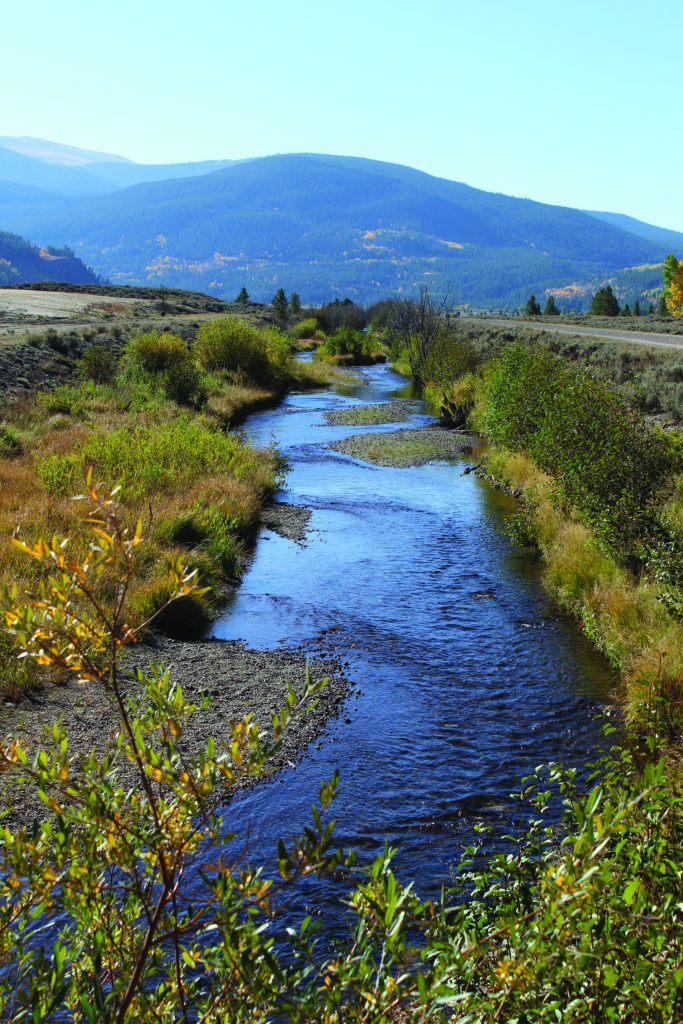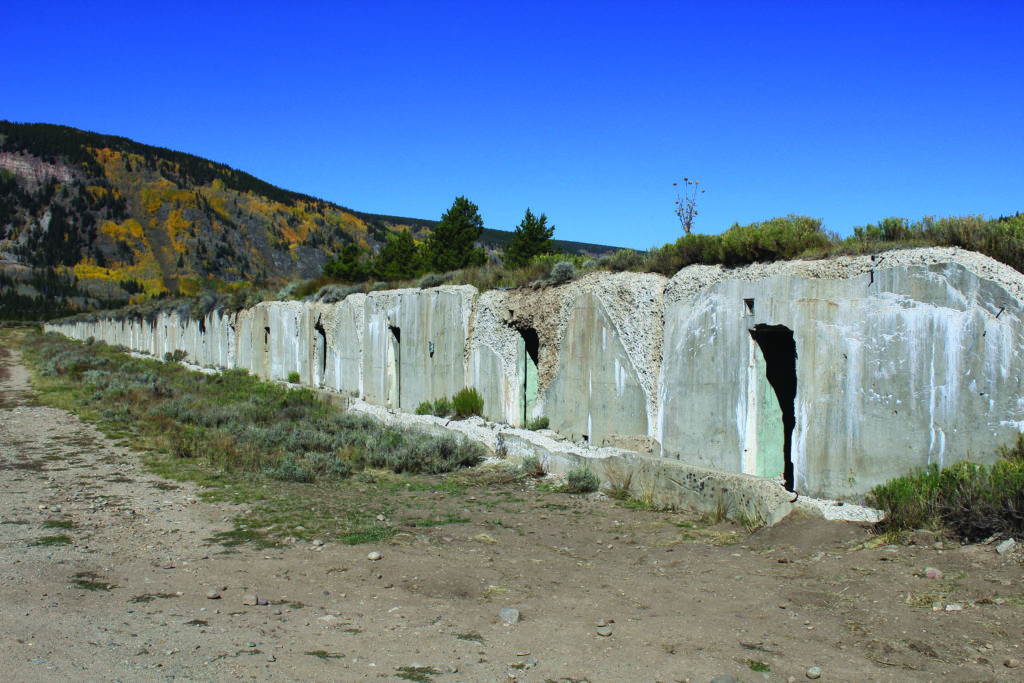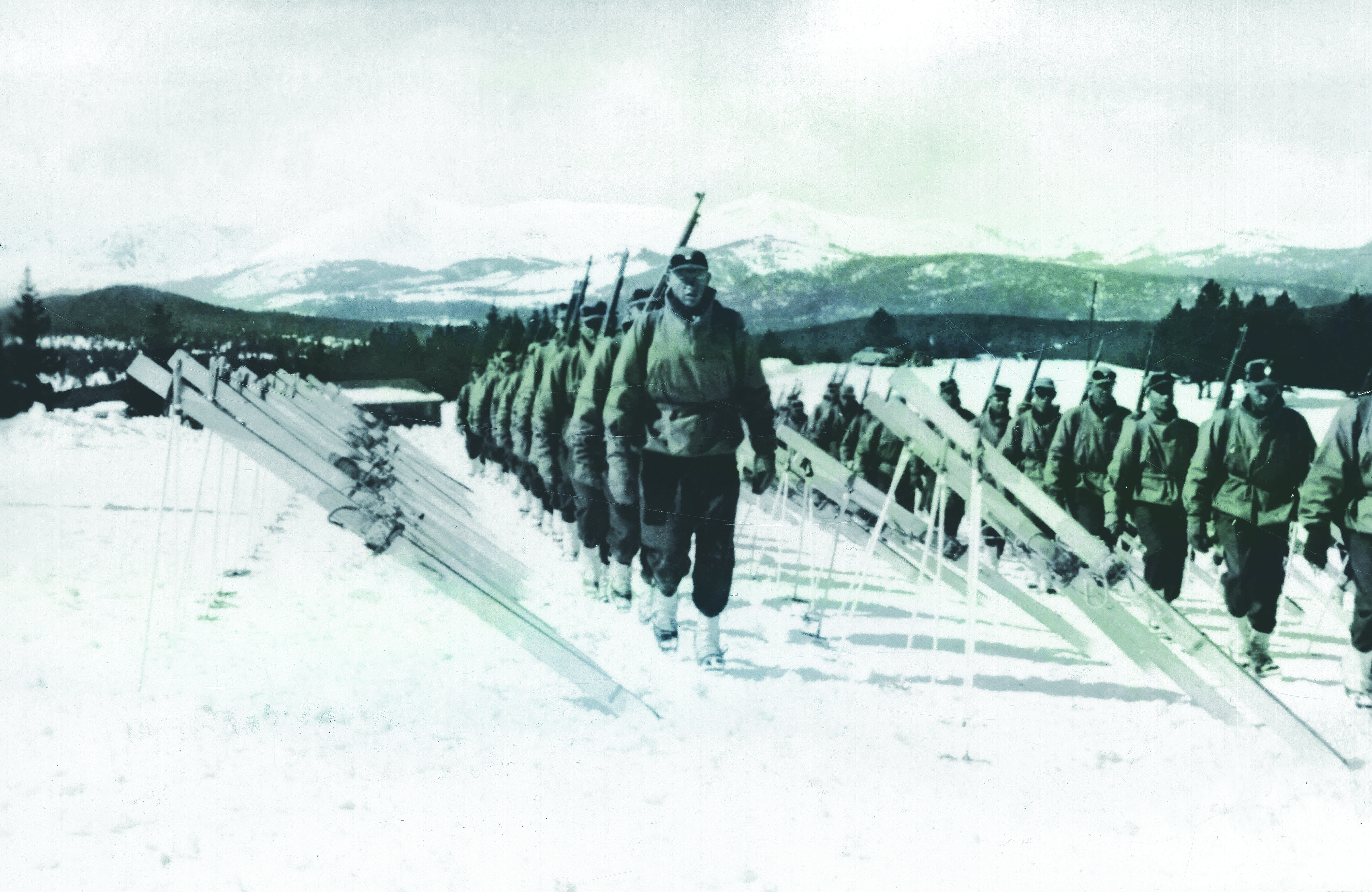Once the highest-elevation U.S. Army post, Colorado’s Camp Hale provided ski troops with deep snow and challenging terrain.
[dropcap]I[/dropcap]n the early evening shadows of Colorado’s Sawatch Range, I pull off the stretch of U.S. Route 24 known as the 10th Mountain Division Memorial Highway and step out to survey a mountain valley a half-mile wide by five miles long. Flat and seemingly empty save a few lonely roads and one suspiciously straight river, this was once Camp Hale, the highest-elevation U.S. Army post, where 15,000 adventurous young men were sculpted into the only American military division dedicated to mountain warfare.
As World War II raged in Europe, reports of ski-clad Finnish troops warding off Soviet invaders in late 1939 led U.S. officials to consider fielding their own specialized mountain warriors. The War Department activated the 87th Mountain Infantry Regiment at Fort Lewis, Washington, in November 1941 and contracted the civilian National Ski Patrol as its official recruiter. Skiing was then a fledgling sport in the States; most of the initial volunteers were Ivy League athletes, wealthy sportsmen, or expatriate European professionals.
That first winter, the 87th trained on the steep slopes of Mount Rainier, 70 road miles east of Fort Lewis. In April 1942, the army broke ground on a camp in Colorado that could support a 15,000-strong division year-round for ski training as well as summer mountaineering. Nestled 9,200 feet above sea level in the Eagle River Valley, the site promised deep snow and easy access to the challenging terrain of the Southern Rockies. To make space and firm ground for the camp’s 900-plus buildings, engineers hacked away thousands of willows and straightened the Eagle’s curves. Seven months and $31 million later, via a freshly laid spur of the Denver & Rio Grande Western Railroad, the first trainees arrived at the camp, named for Spanish–American War veteran and Veterans of Foreign Wars cofounder Brigadier General Irving Hale.


The 87th quartered in barracks, but I check into the U.S. Forest Service-managed Camp Hale Memorial Campground in the southwest corner of the valley, where soldiers once practiced bayonet maneuvers. Amid a sea of motor homes, I pitch the only tent in sight and am soon lulled to sleep by the hum of RV generators.
In the brisk morning, I walk north along B Street, once the main north-south drag and now the only one. Between frequent present-day signs warning of unexploded munitions and asbestos should one stray from the roads, the climbing sun illuminates lines of swollen earth and crumbling concrete pads, tiny hints of this sleepy valley’s livelier past. Across the Eagle’s brushy banks I spot the shabby remnants of livery stables that sheltered the 5,000 pack mules used to haul artillery into the backcountry; it took a team of six to ferry a single 75mm pack howitzer. Between the mules and the nearby rifle range and grenade court, I’m sure wartime B Street strolls were far less serene.
In addition to traditional army training, mountain troops learned to build snow caves, fight forest fires, drive dogsleds, and climb the sheer cliffs that form the eastern wall of the valley. On the self-guided driving tour around the Camp Hale National Historic Site, I stop at each of 10 interpretive signs that piece together the mountain troops’ story and point out the dusty scars of the camp hospital, service club, and other structures.
In solidarity with the soldiers, I decide to hike what is now the Colorado Trail six miles from Camp Hale to Cooper Hill, a training spot atop the Continental Divide at Tennessee Pass. It’s late September, that brief, glorious time in the Rockies when turning deciduous trees mingle with evergreens to create sherbet stripes along the mountainsides. My head throbs with the low humidity and high altitude—about 7,500 feet higher than my northwest Montana home, and well above the maximum elevation the troops would reach in combat. Dizziness and fatigue were common problems for the trainees, who carried 82 pounds of gear on this hike, not including their skis and M1 rifles.

When the National Ski Patrol recruiters had exhausted the pool of service-eligible skiers, they leveraged extensive media coverage and War Department-sponsored films to lure other outdoorsmen into the Colorado wilderness. Fishermen, lumberjacks, rodeo clowns, and more came to Camp Hale to don the baggy white canvas camouflage of the 85th, 86th, and 87th Infantry Regiments that formed the 10th Light Division (Alpine). Unfortunately, some 80 percent of them had never skied. The army opened Cooper Hill to provide Nordic and alpine training, installing the country’s longest T-bar ski lift. This cheaper, higher-capacity alternative to today’s more ubiquitous chair lift could pull 200 pairs of wobbly skiers at a time more than a mile to the top.
At the modest resort now known as Ski Cooper, the T-bar was replaced by a chair lift dubbed the “10th Mountain Double” in 1973. I stand beneath a chair that’s creaking slightly in the wind and imagine rough formations of novice skiers bumbling down the three bald lines that descend the densely forested hill before me.
Needing sustenance after the return hike to camp, I drive 17 miles to Leadville, established in the 1860s to serve unruly lode miners. Although this was the closest town of any size, Camp Hale recruits were banned from visiting until February 1943, when the army agreed it had sufficiently dimmed its red-light district. Fresh paint and tourism have further transformed Leadville’s streets, which on this Saturday night are hopping with locals and visitors basking in the last few days of fall weather.
The Leadville ban didn’t bother most soldiers, who happily occupied their free time fishing, hunting, hiking, and, naturally, skiing. On a long training march in 1942, troops discovered a struggling mining-turned-ski town called Aspen. “I looked across here and I thought, this is it,” recalled Friedl Pfeifer, a pre-war Austrian slalom champ who served in the 1st Battalion, 85th Infantry Regiment. “From then on I was here every weekend.”
The 87th briefly deployed to the Aleutians in the summer of 1943, just in time to storm the island of Kiska and find that the Japanese had already withdrawn. By March 1944, the entire 10th Light was back at Camp Hale, eager to test its hard-earned skills in combat. It got a taste during D-Series, division-level maneuvers in which more than 12,000 men camped above 13,000 feet for three weeks to cut off a mock enemy battalion. A brutal cold snap proved their most daunting foe. When nightly temperatures plunged to 30 degrees below zero, men slept on their skis to keep their parkas from freezing to the deep snow.
D-Series was the division’s last encounter with extreme weather. On June 20, 1944, the 10th Light was transferred to Camp Swift, Texas, for final infantry training before being assigned to Lieutenant General Lucian K. Truscott’s Fifth Army as the 10th Mountain Division in January 1945. Although they did patrol Italy’s Northern Apennine range on skis, mountaineering would prove their most useful skill as they famously scaled 1,500-foot Riva Ridge in February 1945 to lead the Allied break through the Gothic Line. More than 950 were killed and nearly 4,000 wounded during their long-awaited deployment.
The 10th Mountain Division never returned to Camp Hale. The army held occasional cold-weather war games here, and the CIA briefly trained Tibetan Freedom Fighters before turning the facilities over to the General Services Administration in 1965. Buildings were pieced out, the land was granted to the U.S. Forest Service, and all but the sturdiest concrete remains—ammunition bunkers, a guard shack, and the field house’s pillars—slowly succumbed to erosion and bunchgrass.
The modern 10th Mountain Division is based in Fort Drum, New York, but the legacy of its pioneers echoes strongly through the Rockies and today’s thriving U.S. ski culture. Veterans of the division came home from Italy to dominate the 1948 and 1952 U.S. Olympic ski teams and design, found, or direct 62 ski resorts, including nearby Vail, Breckenridge, and Aspen, where Friedl Pfeifer returned in 1945. As I motor back toward Denver, kicking up flurries of golden leaves, a final glance at those towering peaks in the rearview mirror tells me why. ✯
WHEN YOU GO
The Camp Hale National Historic Site is a two-and-a-half hour drive southwest and way up from Denver International Airport. While skiers may be tempted to make Camp Hale a winter getaway, deep snow and treacherous travel conditions make May through October the best time to visit.
Where to Stay and Eat
No lodging will get you closer than a $21/night tent or RV site at the Camp Hale Memorial Campground. Nearby Leadville and Red Cliff offer standard accommodations and such campfire-besting fare as The Leadville Grill’s signature white chili-stuffed sopapillas. Finer billeting and dining is found in the ski towns. In Aspen, try the Gulf Coast Style Fish Sandwich at The White House Tavern, a cozy pine-paneled miner’s cottage built in 1883.
What Else to See and Do
The Southern Rockies are a hiker’s and mountain biker’s paradise. For less arduous adventures, celebrate the 10th Mountain Division at the Colorado Snowsports Museum and Hall of Fame in Vail; take a colorfully narrated ride on the Leadville, Colorado & Southern Railroad; or play the highest-altitude nine holes in the United States at Leadville’s affordable Mt. Massive Golf Course. ✯
This story was originally published in the August 2019 issue of World War II magazine. Subscribe here.





